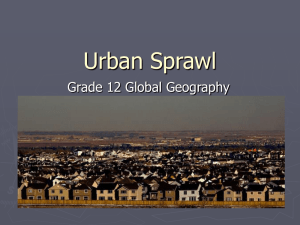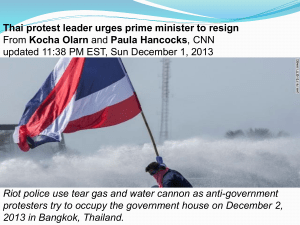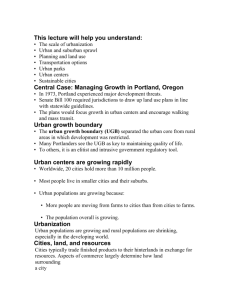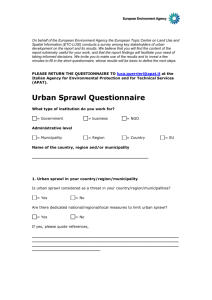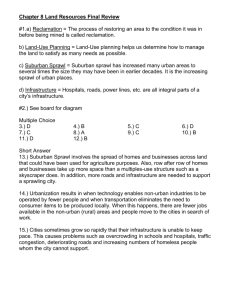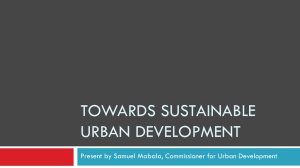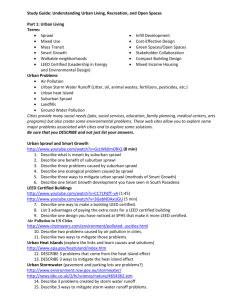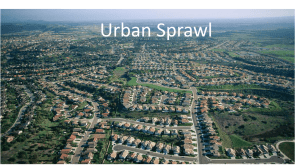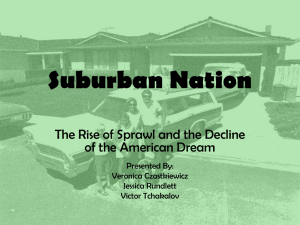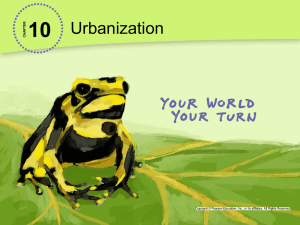Implications of Urban Sprawl
advertisement
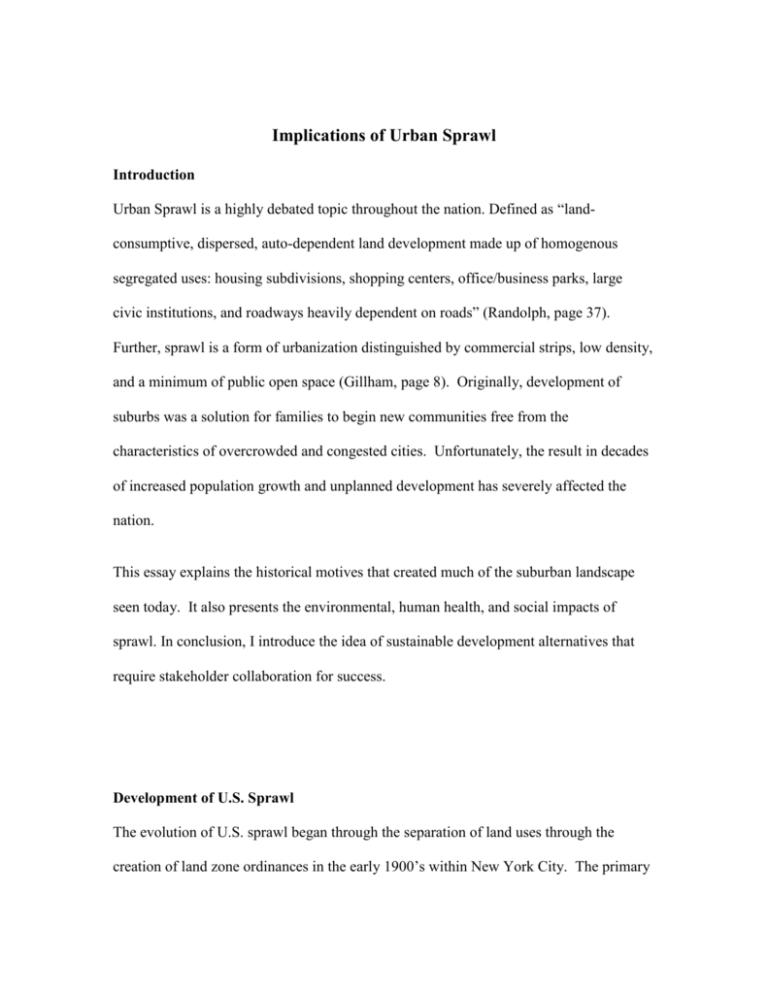
Implications of Urban Sprawl Introduction Urban Sprawl is a highly debated topic throughout the nation. Defined as “landconsumptive, dispersed, auto-dependent land development made up of homogenous segregated uses: housing subdivisions, shopping centers, office/business parks, large civic institutions, and roadways heavily dependent on roads” (Randolph, page 37). Further, sprawl is a form of urbanization distinguished by commercial strips, low density, and a minimum of public open space (Gillham, page 8). Originally, development of suburbs was a solution for families to begin new communities free from the characteristics of overcrowded and congested cities. Unfortunately, the result in decades of increased population growth and unplanned development has severely affected the nation. This essay explains the historical motives that created much of the suburban landscape seen today. It also presents the environmental, human health, and social impacts of sprawl. In conclusion, I introduce the idea of sustainable development alternatives that require stakeholder collaboration for success. Development of U.S. Sprawl The evolution of U.S. sprawl began through the separation of land uses through the creation of land zone ordinances in the early 1900’s within New York City. The primary purpose of zoning was to separate land uses, keeping residents away from the unpleasant and often environmentally harmful industrial factories (Gillham, page 26). With the development of railroad access, extravagant suburbs were developed to cater the needs of the elite. Following the popularity of automobiles, extensive roadways development and advancements in building technology, suburban living became more affordable for the American public (Gillham, page 27). Demand for entry level single family housing greatly increased with World War II servicemen and their families (Gans, page 1). The most famous proponent of urban decentralization –establishing communities outside the city, Frank Lloyd Wright strongly believed that healthy communities needed to be established far from harmful effects of cities. Factors contributing towards the exodus from cities include economic growth, inadequate education systems, congestion, social decay, crime, racial tensions, zoning laws that segregate uses, and federal policies subsidizing mortgages (Bullard, page 38). Everyday people could now live the American dream of a home, yard and automobile. In 1946, developer William Levitt capitalized on this opportunity and began mass production of “a new city of 17,400 Cape Cod boxes and ranches, each on its own 6,000 square foot lot” in New York (Gillham, page 38). Following extensive highway systems, thousands of similar types of mass produced and aesthetically similar communities developed around cities throughout the nation. Impacts of Urban Sprawl Unplanned and irresponsible sprawl developments have had severe affects on the natural environment, human health, and social divides. Due to massive land consumption, wetlands, riparian land, forests, and agricultural land are converted to subdivisions, shopping centers and roads. These lands no longer perform natural processes crucial to ecosystem health. Fragmented land reduces native habitat for wildlife including over 1000 listed endangered and threatened species such as the five northwest Pacific Salmon, Gray Wolf, and Florida Panther (US Fish and Wildlife website). Native vegetation can be displaced by invasive species that spread outside the yards of suburban homes. With a lack of alternatives, personal automobiles are the primary mode of transportation. Residents conduct more driving, contributing towards traffic congestion, unsustainable oil consumption, degradation of air quality, and climate change. Public health is another major concern of sprawled communities. As a result of spending more time and money commuting in vehicles, a sedentary lifestyle can result in obesity and increase of stress levels. Sources of drinking water are vulnerable to contamination. Converted land reduces natural water filtration resulting in runoff (sedimentation and chemicals) penetrating rivers, lakes, and the ocean. As forest fires continue to increase each year, sprawled communities developed adjacent to forested land can be subjected to high fire threats (Randolph, page 44). Social divides of race and class are common throughout sprawl. The “White Exodus” to suburbs in the 1950s was facilitated by federal mortgage subsidies that assisted movement out of the cities. Federal restrictions made lending difficult to African Americans and other minority groups who desired to move to the suburbs (Bullard, page 3). Sprawl communities can have the inability to deal with pluralism - failure to accept other lifestyles that represent the diversity of American society (Gans, page 65). The consequence is the continuous search for compatible people and the rejections of those who are different (Gans, page 65). Minority and low-income populations continue to primarily reside within the city limits. Alternatives to Urban Sprawl Responsible options for sustainable development are necessary to meet population growth as well as environmental and social needs. Alternatives must also incorporate collaboration between local government, private industry, and non-profit organizations in order to successfully sustain development for current and future needs. Alternatives to sprawl can incorporate both the ideas of new urbanism and centralized development. The development design idea of new urbanism is the “restoration of both the physical design and social values of American neighborhoods” (Fulton, page 5). The design reorients communities to be pedestrian friendly and transit focused while retaining open space. A greater integration of land uses including mixed income residences, workplaces, shops, and schools are retained at a neighborhood level (Fulton, page 5). Centralized development within cities looks to revitalize existing infrastructure while preserving undeveloped land. City dwellers would travel less since workplace and residence would be closer in vicinity (Breheny, page 20). Residents would hopefully choose from already offered and accessible alternative transportation options that ultimately reduces vehicle emissions. Through collaboration, there is a greater incentive for the different stakeholders to work together. As the regulatory entity, the government will need to meet needs of all constituents. Non-profits organizations (e.g. – Cascade Land Conservancy, The Trust for Public Land, low-incoming housing organizations, etc.) have the ability to advocate for policy reform, garner public support, and obtain political backing. It is in the best interest for private industries to work with various stakeholders to gain support for a development project. In addition to regulatory mandates, incentives such as tax subsidies, grants, low interest loans, and land swaps can be offered to help developers commit to responsible and sustainable development. Literature Cited Breheny, Michael (1996), “Centrists, Decentrists and Compromisers: View on the Future of Urban Form”, pp. 13-35, in The Compact City: A Sustainable Urban Form, London: E & FN Spon. Bullard, Robert (2000) “Introduction: Anatomy of Sprawl” Chapter 1, pp. 1-19 in Sprawl City. Robert Bullard, Glenn Johnson and Angel Torres, eds., Washington D.C.: Island Press Gans, Herbert (1967) “Levittown and America” in The City Reader. Richard T. LeGates and Frederic Stout, eds., pp.64-68. London, UK: Routledge. Gillham, Oliver (2002), The Limitless City. Washington D.C.: Island Press Randolph, John (2004) “Land Use Planning for Environmental Management” Chapter 3, pp. 36-52, in Environmental Land Use Planning and Management. Washington D.C.: Island Press.
